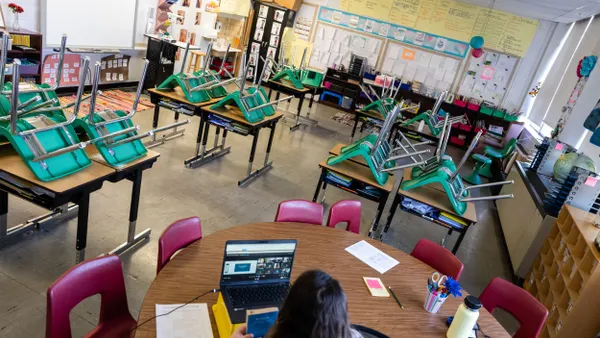Dive Brief:
- Students are more likely to enroll in college if they believe their family can afford the cost of attending, according to a study released Wednesday by the National Center for Education Statistics. The center found a 20-percentage point difference in actual enrollment between students who thought their family could afford college versus those who didn’t.
- A student’s likelihood of attending college increases if at least one parent has earned a college degree or certificate, NCES reported. Among students who didn’t believe their parents could afford college, 71% enrolled if at least one parent had a bachelor’s degree or higher, while only 55% enrolled if one parent had a high school degree or less.
- The data comes from NCES' High School Longitudinal Study of 2009, which surveyed more than 23,000 9th grade students nationwide and tasked them with answering questions between 2009 and 2016. The center then reviewed college transcripts in the 2017-18 school year, analyzing views of college affordability and employment three years after high school.
Dive Insight:
Bill Ziegler, a Pennsylvania high school principal and board member of the National Association of Secondary School Principals, said he’s not surprised by the NCES findings.
“I think students don’t want to put a burden on their family, and that’s where I think as school principals we have a responsibility to come alongside students and teach them how they can afford college even beyond what their family can contribute to scholarships and other things like that,” Ziegler said.
It’s important that communication about college affordability starts at a young age with students and families, said Richard Tench, board chair of the American School Counselor Association and a school counselor at St. Albans High School in West Virginia.
Over the years, Tench said, counselors have become more conscious about highlighting to students and families ways colleges can be affordable. While money has always been stressful for parents and students looking at college, COVID-19’s economic toll has made things even worse, Tench said.
Ziegler agreed: “I think the chasm has grown greater during the pandemic. People have less funds, less money, less resources,” he said.
Views of college affordability can impact enrollment, employment rates
In fact, undergraduate enrollment has declined significantly since the start of the pandemic, reported Higher Ed Dive. About 1 million fewer students enrolled in college in fall 2021 compared to fall 2019 — a 6.6% drop in undergraduate enrollment within two years.
The average cost of tuition and fees is $27,560 for out-of-state students at public four-year colleges and $38,070 for students at private nonprofit four-year colleges, according to College Board reports. Average in-state tuition for public four-year undergraduates was reported at $10,740.
More federal funding is needed to help increase the affordability of college, Ziegler said.
“Colleges are in a tough time right now, and I think personally that we need to restructure how we do funding [in] college,” Ziegler said. “It’s overwhelming for parents.”
As more U.S. bachelor degree institutions continue to offer test-optional or test-blind admissions for fall 2022 and likely beyond, both Ziegler and Tench agree the move will help lift other barriers for college enrollment.
In the NCES study, students who said their family couldn’t afford college were more likely to be employed than enrolled in college. In fact, 43% of those students were working compared to the 38% attending college, and the remaining 20% were not enrolled or employed.
By contrast, students who believed their families could afford college were more likely to be enrolled instead of employed with 58% attending college, 32% working and 10% neither employed nor enrolled.
Tench suggested one possible reason some students are shifting away from college is the growing number of job apprenticeships partnering with districts.
“There’s a worker shortage now, as well, so [companies] are trying to increase their workforce by creating these apprenticeships,” Tench said. “I feel like that’s going to continue to grow in our country where these apprenticeship options will be more readily available for students and allow them to transition into that career and technical world, where colleges may continue to see a decline in their enrollment because those students are being attracted elsewhere.”






 Dive Awards
Dive Awards







